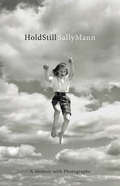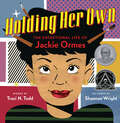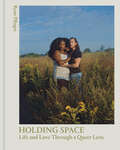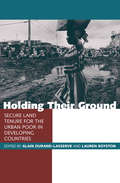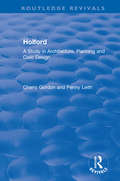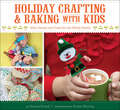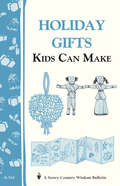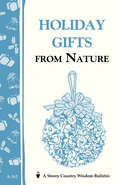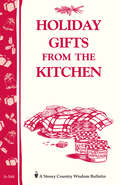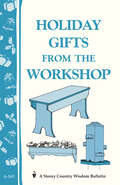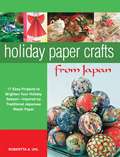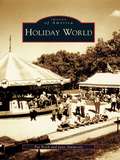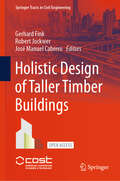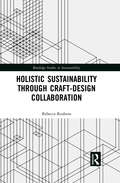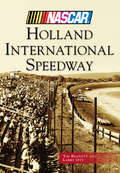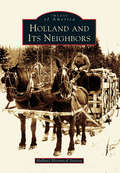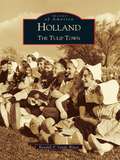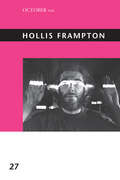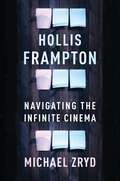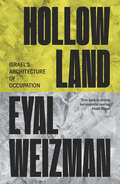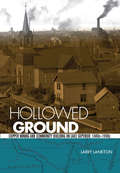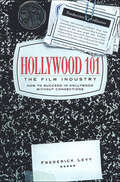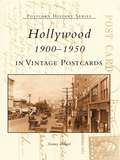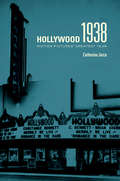- Table View
- List View
Hold Still: A Memoir with Photographs
by Sally MannNATIONAL BOOK AWARD FINALISTONE OF THE BEST BOOKS OF THE YEARThe New York Times, Washington Post, The San Francisco Chronicle, Vogue, NPR, Publishers Weekly, BookPage A revealing and beautifully written memoir and family history from acclaimed photographer Sally Mann. In this groundbreaking book, a unique interplay of narrative and image, Mann's preoccupation with family, race, mortality, and the storied landscape of the American South are revealed as almost genetically predetermined, written into her DNA by the family history that precedes her. Sorting through boxes of family papers and yellowed photographs she finds more than she bargained for: "deceit and scandal, alcohol, domestic abuse, car crashes, bogeymen, clandestine affairs, dearly loved and disputed family land . . . racial complications, vast sums of money made and lost, the return of the prodigal son, and maybe even bloody murder." In lyrical prose and startlingly revealing photographs, she crafts a totally original form of personal history that has the page-turning drama of a great novel but is firmly rooted in the fertile soil of her own life.
Holding Her Own: The Exceptional Life of Jackie Ormes
by Traci N. ToddAn evocative picture book biography about the prolific life of Jackie Ormes, whose groundbreaking cartoons became some of the first empowering depictions of Black women in America! <p><P> Jackie Ormes made history. She was the first Black woman cartoonist to be nationally syndicated in the United States. She was also a journalist, fashionista, philanthropist, and activist, and she used her incredible talent and artistry to bring joy and hope to people everywhere. But in post-World War II America, Black people were still being denied their civil rights, and Jackie found herself in a dilemma: How could her art stay true to her signature "Jackie joy" while remaining honest about the inequalities Black people had been fighting? <P><P><i>Advisory: Bookshare has learned that this book offers only partial accessibility. We have kept it in the collection because it is useful for some of our members. Benetech is actively working on projects to improve accessibility issues such as these.</i>
Holding Space: Life and Love Through a Queer Lens
by Ryan PflugerFeaturing 100 stunning color photographs of queer, interracial couples taken by a renowned photographer for the New York Times Magazine, Time, Rolling Stone, and more, this incredible photo and story collection depicts modern love and relationships in all their joy, vulnerability, and affection. Throughout 2020 and 2021, during a time of intense personal and political upheaval, artist, advocate, and photographer Ryan Pfluger set out to capture intimate images of queer, interracial couples, along with personal insight into their relationships in today's world. Featured together for the first time in Holding Space, this unique collection of modern love in its many forms across the spectrum of race, sexuality, and gender identity and gives space to these couples to share short, revealing stories about their relationships. The photos in this collection, and the people in them, can be startling in their openness, playful in their poses, and tender to their core. Pfluger has captured the magic, honesty, and beauty of love in today's queer culture. With a Foreword by Janicza Bravo and an essay by Brandon Kyle Goodman
Holding Their Ground: Secure Land Tenure for the Urban Poor in Developing Countries
by Alain Durand-Lasserve Lauren RoystonSecurity of land tenure for the urban poor is now a major problem for developing cities in Africa, Asia and Latin America. This book presents and analyzes the main conclusions of a comparative research programme on land tenure issues. It looks at how solutions can be found and implemented to respond to the demands and needs of the majority of squatters and informal settlements, and analyzes how urban stakeholders, with different social, legal and economic constraints, find innovative and flexible solutions. The book is intended to fill a gap in the literature on comparative research on tenure policies and should be useful to researchers and professionals involved in defining and instigating tenure upgrading policies and programmes.
Holford: A Study in Architecture, Planning and Civic Design (Routledge Revivals)
by Gordon E. Cherry Leith PennyOriginally published in 1986 Holford is not just a biography of a major architect, planner and civic designer. In describing the life and times of the man, the authors provide a fascinating analysis of the developments in British architecture and planning from the 1930s to the 1970s. The book explains the story of a wartime policies for post-war reconstruction and examines policies which have had a major influence on the shaping of modern towns and cities. Holford’s involvement in planning in the post-war period shows how gradually the concept of ‘civic design’ has been discarded to the detriment of the urban landscape. His position in the thick of development conflicts, such as that of Piccadilly, have much to tell us about the workings of developers and planning authorities, and the failings of the planning system in the pressures for growth in the 1960s. In this key period of British architectural and planning history, Holford was a leading actor, and describing his role the book provides a very readable account of a little explored area.
Holiday Crafting & Baking with Kids: Gifts, Sweets, and Treats for the Whole Family!
by Jessica StrandKid-friendly crafts and recipes for traditional holiday festivities—from an autumn wreath to paper snowflakes, matzo bark to a popcorn Kwanzaa collage. Holiday Crafting & Baking with Kids will bring the whole family together for some good holiday fun. Children ages four and up will love selecting their own materials and digging into these cheerful projects. There is something here for everyone and every winter occasion Thanksgiving, Hanukkah, Kwanzaa, Christmas, New Year’s, and Boxing Day! Step-by-step instructions, helpful templates, and color photos make it a cinch for little ones to follow along. Best of all, the materials and ingredients for these projects are inexpensive, easy to find, and even easier to turn into amazing gifts, decorations, and treats.“Such a wonderful holiday catch-all.” —In the Know Mom“Enjoy some family bonding time with the young ones, using these easy to follow and inexpensive suggestions for holiday treats.” —Kirkland Reporter
Holiday Crafts: 50 Projects for Year-Round Family Fun
by Linda ReeceThe sweet and simple projects in Holiday Crafts will be sure to make lasting memories, not to mention priceless mementos. Author Linda Reece, mommy blogger and crafter, believes that no one likes to be plopped in front of the TV during family gatherings and celebrations. Spending time with your little ones doing simple crafts and actives is a perfect way to bring cheer to every holiday. Filled with fifty year-round holiday-themed crafts for ages 3-10, hours of enjoyment are guaranteed for children and parents alike. The easy-to-follow instructions, cheerful design, full-color-photographs, and simple supply lists will ensure the success of any little crafter. The book contains five crafts for ten different holidays, including Christmas, Thanksgiving, 4th of July, Halloween, Back to School, Mother’s Day, Father’s Day, Easter, St. Patrick’s Day, and Valentine’s Day. Inside you will find: * Father’s Day Tie Card * Stuffed Heart Valentine * Paper Clover Craft * And so much more! There are also non-craft activates sprinkled inside for a little bit of added fun. The projects in Holiday Crafts are perfect for young children to interact with parents, grandparents, and whoever else wants to join in!
Holiday Gifts Kids Can Make: Storey's Country Wisdom Bulletin A-165 (Storey Country Wisdom Bulletin Ser.)
by Editors of Storey PublishingSince 1973, Storey's Country Wisdom Bulletins have offered practical, hands-on instructions designed to help readers master dozens of country living skills quickly and easily. There are now more than 170 titles in this series, and their remarkable popularity reflects the common desire of country and city dwellers alike to cultivate personal independence in everyday life.
Holiday Gifts from Nature: Storey's Country Wisdom Bulletin A-162
by Cornelia M. ParkinsonSince 1973, Storey's Country Wisdom Bulletins have offered practical, hands-on instructions designed to help readers master dozens of country living skills quickly and easily. There are now more than 170 titles in this series, and their remarkable popularity reflects the common desire of country and city dwellers alike to cultivate personal independence in everyday life.
Holiday Gifts from the Kitchen: Storey's Country Wisdom Bulletin A-164 (Storey Country Wisdom Bulletin Ser.)
by Editors of Storey PublishingSince 1973, Storey's Country Wisdom Bulletins have offered practical, hands-on instructions designed to help readers master dozens of country living skills quickly and easily. There are now more than 170 titles in this series, and their remarkable popularity reflects the common desire of country and city dwellers alike to cultivate personal independence in everyday life.
Holiday Gifts from the Workshop: Storey's Country Wisdom Bulletin A-163
by Editors of Storey PublishingSince 1973, Storey's Country Wisdom Bulletins have offered practical, hands-on instructions designed to help readers master dozens of country living skills quickly and easily. There are now more than 170 titles in this series, and their remarkable popularity reflects the common desire of country and city dwellers alike to cultivate personal independence in everyday life.
Holiday Paper Crafts from Japan
by Robertta A. UhlHoliday Paper Crafts from Japan contains easy-to-follow instructions for making seventeen unique seasonal crafts inspired by washi, the beautiful traditional paper handmade by artisans throughout Japan. Color photographs show finished projects, as well as imaginative ways for displaying them.Holiday Paper Crafts from Japan includes such original projects as gift boxes, ornaments, poinsettia and angel decorations, calendar magnets, wreaths, stars and many more. Unleash your inner crafter and discover the wonderful world of washi!
Holiday World (Images of America)
by Pat Koch Jane AmmesonLouis J. Koch had a dream--one of family, fun, and Christmastime year-round. And so he created Santa Claus Land, the nation's first theme park, in Santa Claus, located in the gentle rolling hills of southern Indiana. Now, six decades later, Koch's legacy lives on at Holiday World and Splashin' Safari. Still owned and operated by the Koch family, Holiday World and Splashin' Safari are consistently voted the friendliest and cleanest parks in the country, and their wooden roller coasters are rated in the top ten list among coaster enthusiasts. The Koch family members treat visitors to the park as family and welcome everyone into what has become a true extension of their home.
Holistic Design of Taller Timber Buildings (Springer Tracts in Civil Engineering)
by Gerhard Fink Robert Jockwer José Manuel CabreroThis open access book presents a comprehensive exploration of the challenges and innovations in designing and constructing taller timber buildings (TTBs). It brings together cutting-edge research on key aspects such as structural design, fire safety, and the environmental impact of timber construction. The work emphasizes a holistic approach, addressing not only the technical complexities—like vibration-based assessments, seismic resistance, and long-term behavior—but also integrating themes of circularity, adaptability, and sustainability. The insights shared in this book stem from the collaborative efforts of the COST Action HELEN (CA20139), a network dedicated to advancing knowledge on TTBs. HELEN combines expertise from multiple disciplines and aims to push the boundaries of timber construction, fostering innovative methodologies that improve the durability, resilience, and overall performance of timber buildings. Through these contributions, the book presents practical solutions and visionary frameworks for sustainable, multi-storey timber construction, aiming to shape the future of timber-based architecture in urban environments.
Holistic Sustainability Through Craft-Design Collaboration (Routledge Studies in Sustainability)
by Rebecca ReubensThis book explores the intersection of craft, design and sustainability in the developing world. It argues that most sustainable design approaches and efforts fall short of implementing holistic sustainability, and in order to reach this goal, design must be underpinned by alternatives to the mainstream, technology-intensive, industrial design paradigm. Renewable materials such as bamboo, cork and hemp – which are abundantly available in the developing world – have the potential to be a viable resource base for sustainable development. Current sustainable design initiatives and approaches already recontextualize these materials using industrial techniques and technologies. However, these efforts fall short of impacting holistic sustainability and tend to focus on the ecological aspect. This book offers the development of one alternative to design for holistic sustainability, called the Rhizome Approach, which draws on existing sustainability praxis and craft. Holistic Sustainability Through Craft-Design Collaboration includes customizable tools which aim to empower designers to guide and evaluate their own designs. Through these tools, and the Rhizome Approach in general, the book aims to enable designers, and students of design, to move beyond green and sustainable design, to holistic sustainability design.
Holland International Speedway
by Larry Ott Timothy M. BennettWith its rural farmlands, rolling landscape, locally owned businesses, and tranquil setting, Holland embodies small-town charm. Yet for 54 summers, since 1960, the quiet splendor is interrupted on many Saturday nights by a particular type of roar. It is Holland's racing heritage, known to locals as "Thunder in the Hills." Over the track's long history, many Holland area residents have worked or raced there or enjoyed the racing action as spectators. Holland International Speedway showcases the many cars, stars, officials, and other developments that make up the history of this beloved local track.
Holland and Its Neighbors (Images of America)
by Holland Historical SocietyHolland and Its Neighbors offers a glimpse of bygone times in a rural area of northeastern Vermont along the Canadian border. Holland is typical of many rural small towns. Its neighboring Canadian towns and Norton, Derby, Morgan, and Charleston, Vermont, have familial, geographical, and historical connections that give the area a unique and cohesive culture. Mills and lumber-related businesses were established early, and as land was cleared, farming also became an important way of life. Holland and Its Neighbors includes photographs of loggers and mill workers, while images of horse-drawn equipment and horse-powered machinery illustrate hard work and long hours on hardscrabble farms. Interesting community characters such as Big Jack, peddler Jabez, fortuneteller Marie, hermit Scotty, and Haw Tabor are also pictured.
Holland: The Tulip Town
by Randall P. Vande WaterOn April 26, 1927, Lida Rogers, a Holland High School biology teacher, suggested an idea to members of the Holland, Michigan Women's Literary Club. The idea was that the city present a "Tulip Day" every spring. Two years later, on May 18, 1929, after scores of visitors viewed more than 100,000 tulips along Holland's curbs, Tulip Time became an annual event.The 1930 Holland Evening Sentinel banner headline read: "Tulip Reigns as Queen of City." Throughout the decade, motion picture and radio personalities visited to promote the festival. The Holland Furnace Company, then the city's largest corporation, sponsored special radio programs that were broadcast nationwide.After World War II, Holland saw the festival grow into the nation's third largest annual event. Visitors have enjoyed parades that included street scrubbing, "klompen" dancing, floats, and more than 50 bands. When Tulip Time began, 85 percent of the names in the Holland telephone directory were Dutch. Over time, the community's cultural diversity has evolved and is now reflected in the festival.
Hollis Frampton (October Files #26)
by Michael ZrydThe first collection of critical writing on the work of experimental filmmaker Hollis Frampton.Hollis Frampton (1936–1984) was one of the most important experimental filmmakers and theorists of his time, and in his navigation of artistic media and discourses, he anticipated the multimedia boundary blurring of today&’s visual culture. Indeed, his photography continues to be exhibited, and a digital edition of his films was issued by the Criterion Collection. This book offers the first collection of critical writings on Frampton&’s work. It complements On the Camera Arts and Consecutive Matter, published in the MIT Press&’s Writing Art series, which collected Frampton&’s own writings. October was as central to Frampton as he was to it. He was both a frequent contributor—appearing in the first issue in 1976—and a frequent subject of contributions by others. Some of these important and incisive writings on Frampton&’s work are reprinted here. The essays collected in this volume consider Frampton&’s photographic practice, which continued even after he turned to film; survey his film work from the 1960s to the late 1970s; and explore Frampton&’s grounding in poetics and language. Two essays by the late Annette Michelson, one of the twentieth century&’s most influential writers on experimental film, place Frampton in relation to film and art history. ContributorsGeorge Derk, Ken Eisenstein, Hollis Frampton, Peter Gidal, Barry Goldensohn, Brian Henderson, Bruce Jenkins, Annette Michelson, Christopher Phillips, Melissa Ragona, Allen S. Weiss, Federico Windhausen, Lisa Zaher, Michael Zryd
Hollis Frampton: Navigating the Infinite Cinema (Film and Culture Series)
by Michael ZrydHollis Frampton was an American filmmaker, photographer, and theorist who bridged the experimental film and contemporary art worlds in the 1960s and 1970s. Best known for avant-garde films including Zorns Lemma (1970) and (nostalgia) (1971), Frampton spent his later years working on the unfinished epic Magellan, a monumental cycle that used the metaphor of Ferdinand Magellan’s circumnavigation of the world to rethink the natures and meanings of history, modernity, and cinema. Frampton’s career was cut short by cancer at age 48, with his vast ambitions for the project left incomplete.This book is a groundbreaking and comprehensive account of this remarkable figure’s work in its totality, from Frampton’s earliest films through Magellan. Michael Zryd explores the connections linking Frampton’s art and thought to other media forms, histories, and cultural frameworks. He foregrounds Frampton’s notion of the “infinite cinema,” which redefined the parameters of the medium to encompass all forms of moving image and sound media across the past and future of cinematic possibility. Zryd analyzes Frampton’s ambivalent relationship with modernism and the Enlightenment, showing how the artist navigated between attraction to radical artistic investigation and awareness of this tradition’s implication in colonialism and other oppressive power structures. Shedding new light on Frampton’s project of exploring and critiquing how cinema attempts to capture and understand the world, this book also considers his significance for contemporary art.
Hollow Land: Israel's Architecture of Occupation
by Eyal WeizmanAcclaimed exploration of the political space created by Israel&’s colonial occupationThis new edition of the classic work on the politics of architecture—and the architecture of politics—appears on the fiftieth anniversary of the Six-Day War, which expanded Israel&’s domination over Palestinian lands.From the tunnels of Gaza to the militarized airspace of the Occupied Territories, Eyal Weizman unravels Israel&’s mechanisms of control and its transformation of Palestinian homes into a war zone under constant surveillance. This is essential reading for those seeking to understand how architecture and infrastructure are used as lethal weapons in the formation of Israel.
Hollowed Ground: Copper Mining and Community Building on Lake Superior, 1840s-1990s
by Larry LanktonDetails a century and a half of copper mining along Upper Michigan's Keweenaw Peninsula, from the arrival of the first incorporated mines in the 1840s until the closing of the last mine in the mid-1990s.
Hollywood 101: The Film Industry
by Frederick LevyLooking for a career in the film business? Look no further.Making it in Hollywood is possible. But only if you have a workable strategy. When author Frederick Levy launched his own fledgling career, he didnt' know a soul in the business. But that didn't stop him and it doesn't have to stop you. Hollywood 101 is a complete game plan for getting your foot in the door of the film industry. With fascinating inside stories and advice from key players, it takes you step-by-step up the ladder of success. Whether you aspire to be a producer, director, writer, talent agent, and any other behind-the-camera professional, this is the one book you need to turn your "reel" dreams into reality!
Hollywood 1900-1950 in Vintage Postcards
by Tommy DangcilWith the advent of new, inexpensive photographic technology emerging in the United States during the mid-19th century, communication by postcard became a very popular way to exchange travel stories, news, and gossip over the decades. Drawing on a private collection of vintage postcards, this new book features a history of Hollywood, spanning half a century. Exploring Hollywood before and after it became the entertainment capital of the world, these images offer readers a glimpse of some of the city's most interesting places during its Golden Years. Long before motion pictures arrived, when the area was a residential neighborhood of beautiful homes and lemon groves, Hollywood was just another suburb of Los Angeles striving to become a community. From the familiar sights of Metro-Goldwyn-Mayer Studios and the ChinesTheater, to the horse-and-buggy driven dirt roads and pineapple fields at the turn of the century, Hollywood in Vintage Postcards will guide the curious through the city's progress in the first half of the 20th century.
Hollywood 1938
by Catherine JurcaIn Hollywood 1938, Catherine Jurca brings to light a tumultuous year of crisis that has been neglected in histories of the studio era. With attendance in decline, negative publicity about stars that were "poison at the box office," and a spate of bad films, industry executives decided that the public was fed up with the movies. Jurca describes their desperate attempt to win back audiences by launching Motion Pictures' Greatest Year, a massive, and unsuccessful, public relations campaign conducted in theaters and newspapers across North America. Drawing on the records of studio personnel, independent exhibitors, moviegoers, and the motion pictures themselves, she analyzes what was wrong--and right--with Hollywood at the end of a heralded decade, and how the industry's troubles changed the making and marketing of films in 1938 and beyond.
